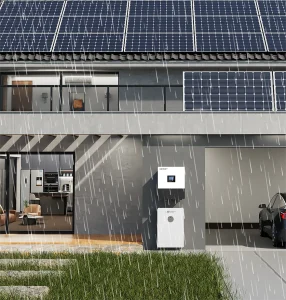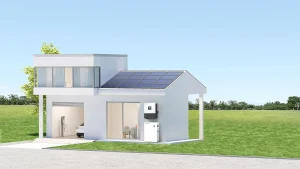W świecie pełnym zaawansowanych technologii i modulacji, niemal we wszystkim musimy polegać na elektryczności. Nagłe przerwy w dostawie prądu mogą utrudnić całą pracę.
W obszarach narażonych na przerwy w dostawie prądu lub w odległych lokalizacjach, niezależność energetyczna to nie tylko wygoda, ale wręcz konieczność. Jeśli mieszkasz wiele kilometrów od obszarów miejskich, być może doświadczasz długotrwałych przerw w dostawie prądu.
Czy tak jest? Niezależność energetyczna jest rozwiązaniem; kluczem jest sposób jej osiągnięcia i metody, jakie należy zastosować.
Dlaczego niezależność energetyczna jest ważna?

Niezależność energetyczna to nowa droga do sukcesu i przystępnych cen energii. Koniec z rachunkami za prąd i stresem związanym z przerwami w dostawach prądu. Oto kilka dodatkowych korzyści, które można osiągnąć dzięki niezależności energetycznej.
Nieprzerwane zasilanie
Wyobraź sobie przykład kompleksowego systemu solarnego zasilającego fabrykę. W ciągu dnia fabryki muszą korzystać z paneli słonecznych, gdy jest dostępne światło słoneczne.
A co, jeśli zapadnie noc lub nadejdą chmury? Jeśli posiadasz system akumulatorów, zyskujesz niezależność energetyczną 100% i możesz korzystać z nieprzerwanego zasilania, bez konieczności korzystania z sieci energetycznej lub lokalnych źródeł energii.
Oszczędność kosztów
Korzystając z sieci energetycznej, należy wziąć pod uwagę kilka kwestii.
- Koszt jednostki zużytej energii elektrycznej
- Opłaty za konfigurację
- Marnowanie energii słonecznej.
A co, jeśli masz niezależne źródło zasilania i nie martwisz się rachunkami za prąd? To już nie marzenie, a fakt. System niezależny energetycznie działa inaczej i eliminuje rachunki. Oszczędzasz energię w bateriach i ustawiasz je jako źródło zapasowe.
Odpowiedzialność za środowisko
Jeśli chcesz, aby Twoje otoczenie stało się lepszym miejscem do życia, to jest to właściwy wybór. Niezależność energetyczna jest możliwa tylko dzięki odnawialnym źródłom energii. Oznacza to, że możesz zmniejszyć ślad węglowy i wytwarzać energię, która nie szkodzi Twojemu środowisku.
Dzięki takiemu odpowiedzialnemu zachowaniu inni docenią twoje wysiłki.
Bezpieczeństwo i odporność
Nie jesteś podatny na awarie ani nagłe przerwy w dostawie prądu. System Solarny ma mniej przestojów i działa nawet w pochmurny dzień.
Dzięki wytrzymałej konstrukcji i praktycznemu montażowi jest w stanie stawić czoła trudnym warunkom środowiskowym.
Przewodnik krok po kroku, jak stać się niezależnym energetycznie

Weźmy na przykład typowe gospodarstwo domowe: dzienne zużycie energii elektrycznej wynosi 10 kWh, a aby zapewnić normalne zasilanie nawet w pochmurne dni, należy wyposażyć je w panele słoneczne o mocy 4 kW i akumulatory o pojemności 15 kWh.
Jeśli chcesz stać się niezależny energetycznie, musisz wykonać siedem prostych kroków.
Krok 1: Oceń swoje zużycie energii
Gdzie wdrażasz system niezależności energetycznej? Jeśli w domu, to w domu pracuje kilka urządzeń o różnym poborze mocy.
Na przykład:
- Oświetlenie
- Sprzęt AGD (lodówka, telewizor, klimatyzacja itp.)
- Urządzenia ładujące (telefony, laptopy)
- Pompy wodne lub inne niezbędne elementy
W sektorze komercyjnym mogą to być ciężkie maszyny i inne narzędzia. Wystarczy zmierzyć zapotrzebowanie na energię, a następnie przejść do dalszej selekcji.
Krok 2: Zmniejsz zapotrzebowanie na energię
Czy chcesz przejść na lepsze środowisko, w którym zużycie energii jest mniejsze? Mniejsze zużycie oznacza lepsze przestrzeganie zasad energooszczędnych systemów energetycznych i niższe koszty.
Oto jak możesz pracować mądrze.
- Przejdź na oświetlenie LEDZużywa o 80% mniej energii niż tradycyjne żarówki.
- Przejdź na urządzenia energooszczędneModele Energy Star i inwerterowe to prawdziwe rozwiązania energooszczędne.
- Ociepl swój dom. Zmniejsza potrzebę ogrzewania i chłodzenia oraz zapobiega nagłym przegrzaniom.
- Używaj inteligentnych listew zasilających. Zapobiegaj utracie energii fantomowej z urządzeń będących w stanie bezczynności.
Krok 3: Wybierz źródło zasilania
Jakiego rodzaju źródła zasilania potrzebujesz? Po pierwsze, upewnij się, że jest odnawialne i zrównoważone, aby nie miało znaczącego wpływu na środowisko.
Typowymi źródłami energii mogą być energia słoneczna, energia wiatru i systemy hydroelektryczne.
- Energia słoneczna to wartościowe źródło, którego energia dociera do Ziemi przez miliony lat. Nie trzeba inwestować dużych środków we wdrożenie tego systemu.
- Energia wiatrowa Jest to alternatywne źródło energii, ale jego wydajność zależy od prędkości wiatru, a sprzęt wymaga wyższych kosztów utrzymania. Wykorzystanie energii wiatrowej wymaga drogich turbin i ich konserwacji.
- Mikroenergia wodna wymaga stałego przepływu wody i nadaje się do stosowania w obszarach położonych w pobliżu rzek lub strumieni.
Krok 4: Zainstaluj system magazynowania energii w akumulatorach
Jeśli instalujesz system fotowoltaiczny, wybierz panele monokrystaliczne lub polikrystaliczne. Są wydajne i niedrogie, zaspokajając zapotrzebowanie na energię.
Następnym krokiem jest zakup systemu akumulatorowego. Dlaczego? Ponieważ może on magazynować energię i oddawać ją w okresach braku światła słonecznego lub pochmurnego nieba.
Jest jeszcze wiele do odkrycia.
- Dostępne są akumulatory kwasowo-ołowiowe i litowo-jonowe. Zazwyczaj preferowane są akumulatory litowo-jonowe ze względu na ich długą żywotność, głębokość rozładowania i wysoką wydajność.
- Akumulatory litowo-jonowe charakteryzują się dłuższą żywotnością (ponad 10 lat) i większą głębokością rozładowania (80-90%), natomiast akumulatory kwasowo-ołowiowe są tańsze, ale mają krótszą żywotność (3-5 lat).
- Oblicz pojemność akumulatora na podstawie tego, przez ile godzin chcesz mieć zasilanie awaryjne.
Krok 5: Zintegruj falownik
Falownik to mózg Twojego systemu energii słonecznej. Pomaga przekształcać energię słoneczną w prąd przemienny i sprawia, że jest ona opłacalna dla urządzeń domowych.
Falowniki powinny mieć funkcję automatycznego przełączania, aby płynnie przejść na zasilanie z akumulatorów lub generatorów zapasowych, gdy energia słoneczna jest niewystarczająca.
Wybierz falowniki z funkcjami takimi jak płynne przełączanie zasilania, kompatybilność z wieloma typami akumulatorów i priorytetyzacja obciążenia.
- Bezproblemowe przełączanie między zasilaniem słonecznym, akumulatorem i generatorem.
- Zintegruj zarówno z akumulatorami litowo-jonowymi, jak i kwasowo-ołowiowymi
- Nadaj priorytet obciążeniom krytycznym
- Automatyczne ładowanie akumulatorów, gdy dostępna jest nadwyżka energii
- Zapewnij zdalny monitoring za pomocą aplikacji mobilnych i internetowych
Krok 6: Monitoruj i optymalizuj
Monitorowanie wydajności w czasie rzeczywistym jest niezbędne do optymalizacji systemu. Jeśli produkcja energii jest niewystarczająca lub występują błędy, można je natychmiast sprawdzić i rozwiązać.
Korzystaj z systemów monitorujących, aby na bieżąco śledzić zużycie energii słonecznej, stan baterii i obciążenie. Dzięki temu możesz na bieżąco wprowadzać zmiany optymalizujące efektywność energetyczną.
Powinieneś otrzymać:
- Zdalne panele kontrolne umożliwiające sprawdzenie zużycia energii słonecznej, stanu akumulatora i obciążenia.
- Alerty dotyczące nieprawidłowego napięcia akumulatora lub usterek systemu, pozwalające na naprawę lub wymianę podzespołów systemu.
- Rejestrowanie danych w celu analizy trendów i poprawy wykorzystania energii.
Ostatnie myśli
Energia słoneczna to jeden z nowych i najpopularniejszych sposobów na osiągnięcie niezależności energetycznej. Dzieje się tak ze względu na wysokiej jakości wsparcie, nieograniczone możliwości personalizacji i dostęp do nieograniczonych źródeł energii.
Ta ścieżka produkcji energii charakteryzuje się zerowym śladem węglowym. Czy chcesz mieć możliwość pełnego osiągnięcia niezależności energetycznej?
Skonsultuj się z profesjonalnymi dostawcami, takimi jak Powietrze Aby uzyskać rekomendacje dotyczące falowników i systemów, które spełnią Twoje potrzeby. Oferujemy wsparcie w zakresie energii słonecznej, konsultacje i dostęp do szerokiej gamy rozwiązań. Wdrażaj zasady niezależności energetycznej już teraz w przystępnej cenie!

